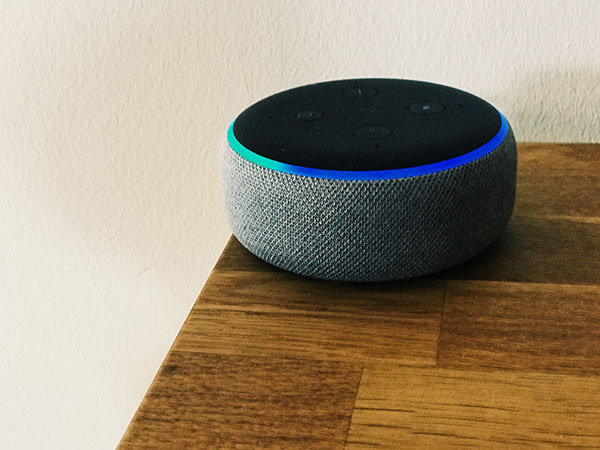Welcome to the Future of Voice Search
Siri. Google. Alexa. These household names have evolved over the years from neat features on our devices to go-to smart assistants. What started as a quick way to find an answer amongst a crowd of people as they debated the origin of nacho cheese has evolved into a feature more and more people are using daily for the sake of convenience.
Over the next four years, the number of voice assistants in use is projected to nearly double from 4.2 billion to 8.4 billion. (Yes, that’s more smart assistants than there are people in the world.)
There are a few reasons why we’ll see an increase in the number of smart assistants, including:
- Smart homes. Multiple assistant devices working together to create a smart home ecosystem is a common scenario today.
- Smart cars. Many newer vehicles, even those that are budget-friendly, are coming with smart features such as Android Auto and Apple Carplay. These features are commonly used and allow people to stay connected while on the road.
- Smart ordering. As online shopping increases, so has the comfort level of people buying through their smart devices. With companies like Amazon implementing order subscription services, verifying purchases has become even simpler through a smart device.
All of the statistics on smart assistants and voice search are trending upward for the foreseeable future.
So, how is voice search and the rise of smart assistants affecting your digital presence? Could you be more effectively utilizing SEO to ensure algorithms are seeking out your knowledge when consumers ask their smart devices questions? Is there a way to get on the good side of smart assistants?
Let’s talk about machine learning, SEO, and the ways your business can use both of these things to establish authority on the interwebs.
OK, Google What is Machine Learning?
Machine learning, in short, is a collection of data used to better understand you, the consumer.
Machine learning is not a new feature, as it has been used by search engines, smart assistants, and social media platforms for years. Machine learning looks at and sorts through data to best find what users want to see.
Karen Hao broke down machine learning and the different ways machine learning utilizes data in an easy-to-digest article in MIT’s Tech Review, The Algorithm.
With smart assistants and voice search in particular, machine learning is used to understand the way your voice sounds. It helps smart assistants like our good friends, Alexa and Siri, match the words you say and how you say them with the information you’re seeking out.
Understanding what machine learning is, is the first step to ensuring your content is optimized during a voice search.
You also need to make sure you’re offering content in a way that both the algorithm and the user can understand. This is the key to having your webpage picked up by smart devices through things like Google voice search.
How Does Voice Search SEO differ from Traditional SEO?
Truth be told, there isn’t a big difference between traditional SEO and voice search SEO.
SEO, at its core, is still heavily related to ensuring that a site is hitting a well-rounded number of words within a given subject that tells an algorithm, “This is what I’m talking about!” The biggest difference is the supplemental information on the page and the way your words are presented.
Smart assistants are most likely to pick up on more conversational tones in text because they understand that’s the kind of response their asker is looking for.
They are also banking on giving a correct answer, therefore they’re more likely to pull information from websites that already have high trust scores with the device’s search engine of choice.
To prepare your website for the increase of smart assistant usage, focus on your SEO first. Ensure that your website is doing whatever it can to be trusted by search engines, including implementing SSL certificates, properly utilizing SEO, and having working links, all on top of adding genuine value through the content you share.
The Relationship Between a Person and Their Smart Device
To best understand how to answer user questions, it’s wise to consider how, why, and where the question is being asked. Data shows that smart devices are often used on the go, making smart devices, and what they have to offer incredibly convenient for users.
making smart devices, and what they have to offer incredibly convenient for users.
How? People are asking smart devices questions in conversational ways. This includes asking questions in fragmented sentences and using simple vocabulary you’d use when talking to a friend or a stranger.
Why? More often than not, when people are asking a smart device a question through voice search, they are trying to avoid having to pull a device out or turn their attention toward a screen for a thorough search. When people use voice search, nine times out of ten, they’re looking for a quick answer.
Where? On public transit. In their cars via features like Apple Carplay. Through their smartwatches in a mall or other public place where they don’t want to take attention away from their surroundings. In their office when they’re multitasking.
Voice search is commonly used while people are multi-tasking, even if that multitasking is just sitting on the couch, watching Netflix, and then wondering where they know that side character from. Whether trying to think of song lyrics or attempting to name all of Snow White’s seven dwarfs, voice search is always about convenience.
Thus, when creating content tailored to smart devices, we must think in terms of convenience.
When creating content for a website, we must put ourselves in a position to answer questions and provide quick access to industry knowledge.
As the popularity of voice assistants grows, straightforward and conversational content will likely become an additional layer to solidifying your site as an authority in your industry.
Will SEO Strategies Need to Adapt to Keep up with Machine Learning Algorithms?
 Savvy SEO strategists know that SEO has an ebb and flow that will always be subject to change a little with the progression of consumption.
Savvy SEO strategists know that SEO has an ebb and flow that will always be subject to change a little with the progression of consumption.
Right now, machine learning algorithms complement every other algorithm. Smart assistants aren’t currently running the game, but their growth is projected to be exponential in the near future as our dependency on smart devices and the convenience of voice searches grow.
The biggest thing for website owners and strategists to keep in mind is to ensure their sites appease the machine learning algorithm while keeping up with traditional SEO efforts. These things operate hand in hand, and a well-rounded website is always the answer to getting more traffic and gaining more traction.
We talk a lot about how web design should speak to an audience and how web copy can help business owners communicate with potential customers, but now, it’s time to consider how our websites would have a conversation with an actual person. Thus, adding easily understood and digestible micro-content to websites may be potentially necessary for making connections with voice-inclined algorithms.
Hey Google, How Can Gravity Junction Help with my Digital Marketing?
Gravity Junction is a marketing and software design company that helps business owners up their digital presence through utilizing top-tier technologies and forward-thinking marketing strategies.
Our goal at Gravity Junction is to always stand out, as we help our clients do the same. We never want your business to fade into the background of fast-moving digital spaces, so we work to set the precedent for the future while living in the present moment, all while looking to the past for a better understanding of the big picture.
As a people-fueled, tech-first marketing company, we are ready to help take your business to the next level. Contact us today.





 making smart devices, and what they have to offer incredibly convenient for users.
making smart devices, and what they have to offer incredibly convenient for users. Savvy SEO strategists know that SEO has an ebb and flow that will always be subject to change a little with the progression of consumption.
Savvy SEO strategists know that SEO has an ebb and flow that will always be subject to change a little with the progression of consumption.




0 Comments